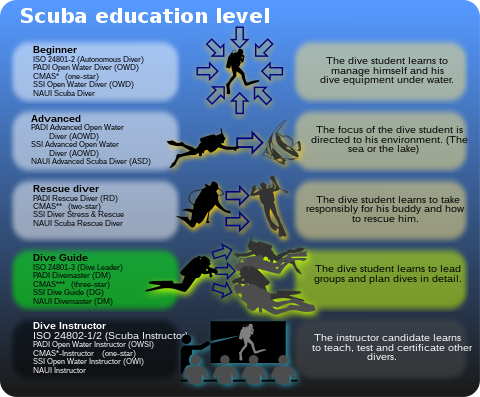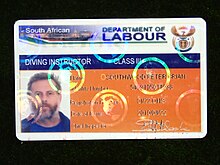


ADiving certificationorC-card is a document (usually a wallet sized plastic card) recognizing that an individual or organization authorized to do so, "certifies" that the bearer has completed a course of training as required by the agency issuing the card. This is assumed to represent a defined level of skill and knowledge in underwater diving. Divers carry a qualification record or certification card which may be required to prove their qualifications when booking a dive trip, hiring scuba equipment, having diving cylinders filled, or in the case of professional divers, seeking employment.
Although recreational certifications are issued by numerous different diver training agencies, the entry-level grade is not always equivalent. Different agencies will have different entry-level requirements as well as different higher-level grades, but all are claimed to allow a diver to develop their skills and knowledge in achievable steps.[1][2]
In contradistinction, a diver's logbook, or the electronic equivalent, is primarily evidence of range of diving experience.
The Diving Certification model originated at Scripps Institution of Oceanography (SIO) in 1952 after two divers died whilst using university-owned equipment.[3] The then President of the University of California, Robert Gordon Sproul, restricted diving to those who had been trained through the program at SIO and thus "certification" was born. A year later Los Angeles county sent Bev Morgan, Al Tillman, and Ramsey Parks to SIO for diver training.[4] Upon their return, these three then developed the Los Angeles Underwater Instructors Program, the oldest such instructor training program in the U.S., and they used the SIO Diver Certification concept.[5]
C-card is the generic term for any certification card issued by a diver certification organization. While sometimes taken to mean the minimum level training required to dive safely, it also applies to advanced and specialization certifications.
A typical card will list:
Dive shops, charter boats and resorts worldwide may demand to see a C-card before filling cylinders, renting equipment, or allowing a person to participate in a dive. This is mainly done to minimize the potential legal liability of the vendor, but may also sometimes prevent untrained people from exposing themselves to hazards of which they are not aware.

There are two European standards with corresponding International standards specifying competence for recreational divers and recreational diving instructors.
The European Standard EN 14153/International Standard ISO 24801 contains minimum standards for recreational divers at three levels and defines the scope of diving for these certifications:
The European Standard EN 14413/International Standard ISO 24802 contains standards for recreational diving instructors:
The International Standard ISO 11107 Recreational diving services specifies the level of competence required of a scuba diver to be awarded an enriched air nitrox (EAN) diver certification by a training organization. These divers are competent to plan, conduct and log EAN open-water, single mixture, open-circuit no-decompression recreational dives, when accompanied by another scuba diver of at least level 2 "Autonomous Diver", and to procure EAN mixes, equipment and other services for recreational EAN diving without supervision.

The Confédération Mondiale des Activités Subaquatiques (CMAS) (World Underwater Federation) oversees an international system of recreational snorkel and scuba diver training and recognition. CMAS publishes minimum training standards which provide an international equivalence system for diver certification issued by its member federations.[9]
The World Recreational Scuba Training Council (WRSTC) publishes a series of nine course standards for recreational diver training.[10] The US national council (RSTC) is the accredited standards developer for the "Diving Instructional Standards and Safety" (Z375) committee of the American National Standards Institute.[11]

The International Diving Schools Association publishes a list of commercial diver certification equivalences, based on the minimum requirements of the association for 4 levels of commercial diver certification:[12]
| Country | IDSA Level 1 Commercial scuba (30m) |
IDSA Level 2 Surface Supplied Inshore Air Diver (30m) |
IDSA Level 3 Surface Supplied Offshore Air Diver (50m) |
IDSA Level 4 Closed Bell Diver (100m) |
|---|---|---|---|---|
| Australia | Part 1 | Part 3 | Part 4 | |
| Belgium | OOW-SYNTRA or OTS-CFPME |
|||
| Canada | Unrestricted SCUBA | Unrestricted SCUBA plus Restricted Surface Supplied Diver | Surface Supplied Mixed Gas Diver to 70m, or Unrestricted Surface Supplied Diver to 50m + Unrestricted SCUBA |
Bell diver |
| Denmark | National SCUBA Diver | Surface supplied diver to 50m | ||
| Finland | National SCUBA Diver | National Surface Supply Diver - 50m | ||
| France | Class 1 Mention A or B | Class 1 Mention A | Class 2 Mention A | Class 3 Mention A |
| The Netherlands | Certificate A | Certificate B | ||
| Italy (Sicily) | Sommozzatore/Inshore diver | Sommozzatore/Inshore diver | Sommozzatore Top up/Offshore air diver | Altofondalista/Offshore sat diver |
| New Zealand | Part 1 | Part 2 | ||
| Norway | NPD Surface Diver | NPD Bell diver | ||
| South Africa | Class 4 | Class 3 | Class 2 | Class 1 |
| Sweden | Diver Certificate A | Diver Certificate B | Diver Certificate C Wet Bell 60m | |
| UK | HSE Part 4 or HSE SCUBA |
HSE Part 3 + Task Training Module or HSE SCUBA + HSE Surface Supply + Tools Training Module |
HSE Part 1 or HSE SCUBA + HSE Surface Supply + Tools Training Module + Surface Supplied Top Up |
HSE Part 2 or HSE Closed Bell |
| USA | American National Standard for Divers - ANSI/ACDE012009 |
{{cite book}}: CS1 maint: location (link)